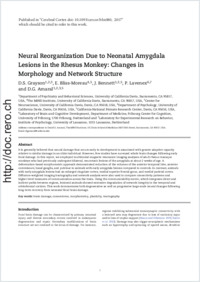Neural reorganization due to neonatal amygdala lesions in the Rhesus monkey: changes in morphology and network structure
- Grayson, D. S. Department of Psychiatry and Behavioral Sciences, University of California Davis, USA - The MIND Institute, University of California Davis, USA - Neuroscience, University of California Davis, USA
- Bliss-Moreau, E. Department of Psychology, University of California Davis, USA - California National Primate Research Center, Davis, USA
- Bennett, J. Department of Psychiatry and Behavioral Sciences, University of California Davis, USA - The MIND Institute, University of California Davis, USA - California National Primate Research Center, Davis, USA
- Lavenex, Pierre Laboratory of Brain and Cognitive Development, Department of Medicine, University of Fribourg, Switzerland - Laboratory for Experimental Research on Behavior, Institute of Psychology, University of Lausanne, Switzerland
- Amaral, David G. Department of Psychiatry and Behavioral Sciences, University of California Davis, USA - The MIND Institute, University of California Davis, USA - Neuroscience, University of California Davis, USA - California National Primate Research Center, Davis, USA
-
2017
Published in:
- Cerebral Cortex. - 2017, p. 1–14
English
It is generally believed that neural damage that occurs early in development is associated with greater adaptive capacity relative to similar damage in an older individual. However, few studies have surveyed whole brain changes following early focal damage. In this report, we employed multimodal magnetic resonance imaging analyses of adult rhesus macaque monkeys who had previously undergone bilateral, neurotoxic lesions of the amygdala at about 2 weeks of age. A deformation-based morphometric approach demonstrated reduction of the volumes of the anterior temporal lobe, anterior commissure, basal ganglia, and pulvinar in animals with early amygdala lesions compared to controls. In contrast, animals with early amygdala lesions had an enlarged cingulate cortex, medial superior frontal gyrus, and medial parietal cortex. Diffusion-weighted imaging tractography and network analysis were also used to compare connectivity patterns and higher-level measures of communication across the brain. Using the communicability metric, which integrates direct and indirect paths between regions, lesioned animals showed extensive degradation of network integrity in the temporal and orbitofrontal cortices. This work demonstrates both degenerative as well as progressive large-scale neural changes following long-term recovery from neonatal focal brain damage.
- Faculty
- Faculté des sciences et de médecine
- Department
- Département de Médecine
- Language
-
- English
- Classification
- Biological sciences
- License
- License undefined
- Identifiers
-
- RERO DOC 288688
- DOI 10.1093/cercor/bhx080
- Persistent URL
- https://folia.unifr.ch/unifr/documents/305474
Other files
Statistics
Document views: 76
File downloads:
- lav_nrd.pdf: 168
- lav_nrd_sm.png: 5

